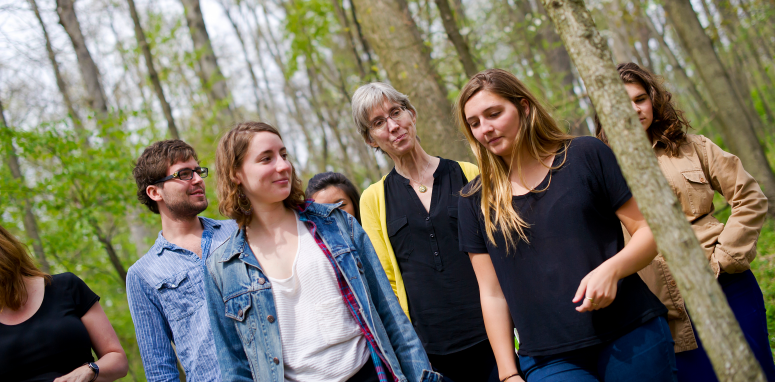Ecosystem Explorers

From Kenyon News - March 3, 2017
Professor of Biology Siobhan Fennessy is familiar with the process of publishing important work — the careful data collection and analysis, the laborious writing, and the exhilarating news of acceptance in an esteemed journal. But a recent publication in Nature Communications was a particular point of pride for the Philip and Sheila Jordan Professor in Environmental Studies because of whom she co-authored the paper with — her former student, Amanda Nahlik ’02.
Their paper, published in late 2016, examines the vital role wetlands play in storing carbon and illustrates the urgent need to protect wetlands in order to avoid releasing carbon into the atmosphere, accelerating climate change. Their study was the first conducted using soil samples from wetlands on a national scale.
Nahlik, now a research ecologist at the U.S. Environmental Protection Agency in Corvallis, Oregon, was one of the first students Fennessy taught at Kenyon in the late 1990s. During the past two decades, Fennessy has watched her former student develop from a budding scientist into a sharp researcher leading the way on projects at the EPA.
“To watch her change from a student into a colleague who’s such a peer is so gratifying,” Fennessy said. “I’m really proud of her.”
Nahlik’s interest in wetlands took root during her time as a Summer Science Scholar at Kenyon, when she worked with Fennessy on research involving amphibian diversity in wetlands. The pair forged a strong connection over the course of the summer, spending long days conducting fieldwork in wetlands across central Ohio.
“Working with people one-on-one in the summer allows you to really dig deep into a project,” Fennessy said. “It’s a great way to get to know people and become very well-connected because of the field work that we do. It can be physically demanding, but it’s the kind of thing you really bond over.”
Nahlik took her summer research to the annual Society of Wetland Scientists meeting her senior year, and her poster presentation was awarded the best at the conference, beating out presentations by graduate and post-doctoral students. Fifteen years later, a plaque signaling Nahlik’s accomplishment still hangs near Fennessy’s office in Higley Hall.
“Siobhan always has been on the cutting edge of wetland research, and it’s really nice that she’s brought her students into that,” Nahlik said.
Fennessy’s work to involve students in her research is now bolstered with the recent addition of an environmental studies major at Kenyon. The major will help students follow in the footsteps of Nahlik, who has worked with Fennessy and the EPA since receiving her doctorate in 2009.
As a post-doctoral fellow with the EPA, Nahlik analyzed data and ran reports for the EPA’s 2011 National Wetland Condition Assessment (NWCA), which Fennessy helped develop. The Nature Communications study by Nahlik and Fennessy used NWCA data to show that human activity and development are correlated with reduced carbon storage in wetland soils.
In their study, Nahlik and Fennessy found that wetlands in the conterminous U.S. store an amount of carbon that is roughly equivalent to four years of annual carbon emissions by the nation. Despite only occupying between 5 and 8 percent of the Earth’s land surface, wetlands hold between 20 and 30 percent of its estimated global soil carbon.
“There’s more carbon held in the soils of the Earth than there is in the atmosphere, and wetlands hold a highly disproportionate amount of that carbon,” Fennessy said.
The professor and her former student have enjoyed more than a bond forged through research; during their decades of shared scholarship, they also have become close friends and call each other at least once a week. Fennessy’s children even participated in Nahlik’s wedding ceremony a few years ago.
“I never thought I would have the opportunity for that sort of relationship with a professor, but Kenyon presented just that opportunity, and it has been pivotal to my life,” Nahlik said.
Fennessy and Nahlik are continuing their research together and have follow-up projects planned using the data they analyzed from the NWCA project. They also are keeping Kenyon students involved in their work; Nahlik recently worked with biology major Lauren Michael ’17 on research in Oregon examining nitrogen levels in coastal wetlands.
“I feel like we’re always plotting the next big thing with our research,” Nahlik said.